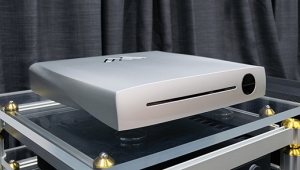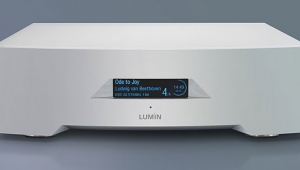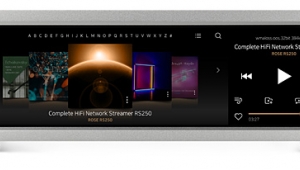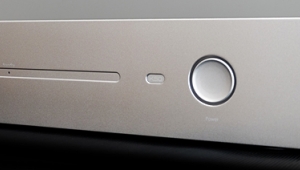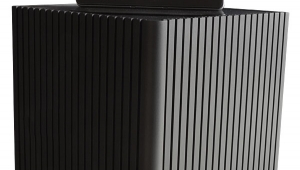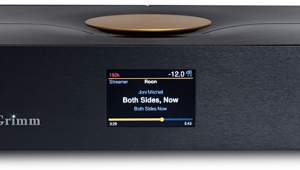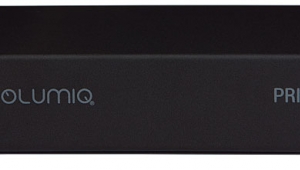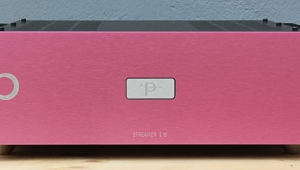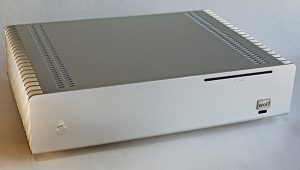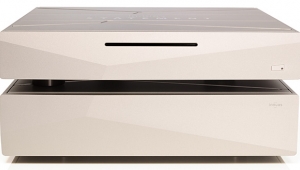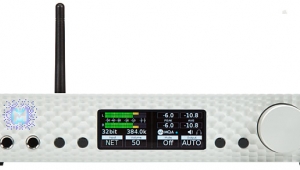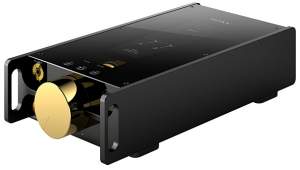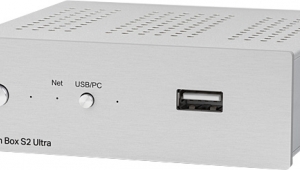| Columns Retired Columns & Blogs |
Antipodes Oladra server/streamer/reclocker Page 2
Input is by Ethernet. Simple. I went from the Uptone Audio EtherRegen, aided by an AfterDark Giesemann Emperor Double Crown Master Clock, to the Nordost QNet Ethernet switch then on to the Oladra.
Footnote 4: When I briefly stole Wilson Pedestals from another component and put them under the Oladra, there was a slight increase in air. Oladra owners are advised to experiment.
Output is more complicated. Antipodes considers I2S (provided over HDMI or RJ45) the Oladra's best-sounding output. It's the only output that can deliver up to PCM 32/384, DSD256 via DoP, and DSD512 native DSD, but many DACs (including my three-piece dCS Vivaldi Apex stack) cannot accept I2S. Other choices, in Antipodes's order of sound-quality preference, are AES3, S/PDIF (BNC and RCA), and USB 2.0. AES3 and S/PDIF are limited to PCM 24/192 and DSD64 via DoP. USB 2.0 can output PCM up to 32/768 and DSD up to 256 via DoP or native DSD up to 512.
There's also "Direct Stream Ethernet." When you use it, the signal emerges direct from the Server engine, out to a streaming DAC, bypassing the Player and Reclocker. This provides bit-perfect transmission of any file the server app can play and pushes the Player app and signal clocking roles onto the DAC. The streaming DAC can be connected via a network switch, but Antipodes provides a direct connection that it says provides the cleanest network delivery to the DAC.
Which server and player should we choose? Users who like to listen without fuss will likely choose the output and software options they prefer and be done with it. Those choices will depend on whether the user seeks ultimate convenience and an information-rich environment (Roon server and player), reduced cost (a free, open-source server and player), or the sound that most pleases them (perhaps an alternative player such as SqueezePlayer or HQPlayer). The choice of output will depend on what DAC is in use, specifically which inputs it supports and which one sounds best.
Some users will want to experiment, but moving among servers, players, and outputs isn't trivial. (The power down/up sequence takes at least two minutes, and Antipodes recommends connecting only one output cable at a time for optimal sound quality.) I was determined to try as many software/output permutations as practical. I don't have a license for HQPlayer, so I tried these combinations: Roon as server and player, Squeeze (which is free) for Server and Player, and Roon server with Squeeze as player. Given the need to complete the review on time, I couldn't have made it all work without generous and much appreciated assistance from Mark Cole, head of service, sales, and marketing for Antipodes.
It isn't just reviewers who need support. Antipodes owners in need of technical assistance can seek it from their local dealer, via phone-plus-remote-access sessions booked in advance via the Antipodes website, or by emailing the company directly. Other options include online chat and a user forum monitored by Antipodes technical support staff. If repairs are needed, your Oladra can be sent to a full-service facility in Denver.
Setup
I placed the Oladra on one of the top shelves of my Grand Prix Monza double rack, to the right of my D'Agostino Momentum HD preamp. I stuck with the Oladra's own feet (footnote 4). Cabling was a mixture of Nordost and AudioQuest. Output choices, to the dCS Vivaldi Upsampler Plus, included USB 2.0, AES3, S/PDIF over BNC, and Ethernet. Due to the Oladra's nondefeatable reclocking feature, applicable on all outputs except USB and Ethernet, I set the dCS Upsampler Plus's clocking choice to "Audio," which allows Oladra's reclocker to do its thing. That meant removing the Vivaldi Master Clock from the chain (footnote 5).
I began listening with D'Agostino Progression M550 mono amplifiers driving my Wilson speakers. Once John Atkinson had finished measuring the Momentum M400 MxV mono amplifiers, which I'd recently fallen in love with, I switched to them. While it is possible to operate the Oladra with an iPad, Cole urged me to use my MacBook Pro instead, because it makes it easier to switch between Roon, Squeeze, and their combinations while switching outputs.
Software again
Oladra's current server software, which is based on Logitech Media Server, has some limitations. Liner-note pdfs are not accessible. Only the bit rate is displayed; if you want to know the sample rate, you must extrapolate from the variable bit rate display. Even though Squeeze software is said to be transparent to MQA, due to a lack of MQA-setting options, I was unable to pass MQA data intact to the Vivaldi Upsampler Plus/Vivaldi Apex DAC unless I used the USB output or streamed direct via Ethernet (footnote 6). Because tracks load during playback, skipping back and forth in a track only works part of the time, and the timing readout is inaccurate. When you load files onto internal storage, the first nine tracks of an album must be indicated as "01-09" (rather than 1–9) or they may not display in the correct order. If the software can't find complete cover information in metadata (footnote 7), it ignores the cover in the recording folder and associates an unrelated cover with the files. As is common in most server software (but not Roon), to search for a title in your library, Tidal, Qobuz, and other services, you must conduct separate searches.
Switching from Oladra's MLP/Squeeze implementation to Roon with SqueezePlayer or Roon by itself sometimes required turning various Roon options and components off and on, refreshing, and more. Of course, this won't be an issue for users who stick with a single interface and output.

Music in all its glory!
Soon enough, I discovered that of the outputs and software I could access, the two Marks' sonic preferences were justified. Music sounded best when I used Squeeze as both server and player and AES3 or S/PDIF (BNC) for the output. (I expect I2S sounds even better, but as I said previously, the dCS cannot accept I2S connection; footnote 8.)
What does "best" mean? Let me jump to my penultimate listen, on Easter Sunday. When I had left the music room the day before, all the equipment was on, but no music was playing. Yet somehow, perhaps due to a short series of momentary power outages caused by gale-force winds, music filled the music room when I returned. Why, short of intervention by divine providence, "Tu virginum corona" (Thou crowned virgin), the heavenly andante from Mozart's early motet Exsultate, Jubilate (Qobuz 24/96, BIS-2171 SACD), was playing, I have no idea. All I know is that the period instruments of Bach Collegium Japan under Masaaki Suzuki began their instrumental introduction just as I walked through the door. I felt I'd never heard sound so open, warm, smooth, maximally colored, and musical through my system. I sat spellbound at the glorious sound of one of Mozart's early acts of genius. When soprano Carolyn Sampson began singing, heaven's gates opened before me.
Then I checked playback settings. Server and player were Squeeze, and the output single AES3. According to the two Marks, this was the optimal combination of server, player, and output for my system.
Reviewer/critic that I am, I couldn't leave well enough alone. I changed to SqueezePlayer with Roon server. As much as I welcomed the many advantages of the familiar Roon interface (footnote 9), sonic colors were a bit less saturated and warm, and instruments had slightly less weight and body. Transparency diminished just a bit, and the soundstage wasn't as open or wide. Nonetheless, the sound was still enrapturing. After I switched outputs from AES3 to USB—so now we're bypassing the Oladra's reclocker—the sound wasn't quite as warm, color-saturated, or transparent.

Morten Lindberg, who records in DXD and prefers the sound of MQA, for two-channel playback at least, recently sent me files of his latest recording, of Trio Mediaeval performing An Olde Hall Ladymass (2L-175, 24/352.8 MQA FLAC). Lindberg's recordings, which benefit from his unusual miking system and careful choice of venue, have few peers when it comes to the depiction of space and air. Because the AES3 input in the dCS Vivaldi Upsampler Plus is limited to 24/88.2 or 24/96, only USB (with Roon) could pass full 24/352.8 MQA FLAC and get me closest to what Lindberg hoped I would play (footnote 10). But nothing could equal the transparency I heard through AES3.
Did I listen to lots of other music, familiar and new? You betcha. In an earlier session, I invited my opera-loving husband to hear a few tracks from Antonio Pappano's new recording of Puccini's final opera, Turandot, with Sondra Radvanovsky, Jonas Kaufmann, Ermonela Jaho, the Chorus and Boy's Chorus of the National Academy of Santa Cecilia in Rome, and the Orchestra of the National Academy of Santa Cecilia, Rome (24/96 WAV, Warner Classics 5419740659). Together, we listened to Princess Turandot's great aria, "In questa reggia," which culminates in a full-throated unison high C from her (Radvanovsky) and her death-defying suitor (Kaufmann) (footnote 11). Along with the glories of Radvanovsky's instrument and the age-darkened sound of Kaufmann's tenor, the air, space, and depth captured by recording engineer Clémence Fabre, with assistance from editor/mixer Peter Hecker and producer/editor/mixer/masterer Jakob Händel, were there to savor fully. Through the Oladra's Squeeze interface and AES3, the sound was wonderful.

Bass checks? Many. Ye olde electronica standby "Electrified II" from Yello's Toy (24/48, Polydor/Qobuz), along with James Blake's "There's a Limit to Your Love" from his eponymous album (16/44.1, Polydor/Qobuz), Terje Isungset's "Fading Sun," from Winter Songs (Ice Music) (16/44.1 FLAC All Ice Records/Qobuz), and the second movement of the Shostakovich Symphony No.11 as performed by the Boston Symphony Orchestra under Andris Nelsons on Shostakovich: Symphonies Nos.4 & 11 (24/96 MQA, DG/Qobuz) delivered as much perfectly controlled bass as I've ever heard from my system. (Of course, the D'Agostino Momentum M400 MxV monoblocks deserve some of the credit, as do my Nordost and AudioQuest cabling, Definitive Audio's Gary Bruestle's fine positioning of the Wilson Alexia V's, and everything else that optimizes system performance.)
Summary
Summa cum laude is perhaps more like it. Fresh from New Zealand, Antipodes Audio's top-line Oladra music server is among the finest sounding music servers I've had in my system. Its current software implementation may not be as user-friendly and easy to operate as Roon (which the Oladra also supports) or the proprietary server/player apps of many of its competitors—a major update is expected in 2024—but its plethora of player, server, and output options make it compatible with most DACs.
If you're in the market for a top-quality music server, the Antipodes Audio Oladra deserves a place on your audition list.
Footnote 4: When I briefly stole Wilson Pedestals from another component and put them under the Oladra, there was a slight increase in air. Oladra owners are advised to experiment.
Footnote 5: The Antipodes folks believe in the superiority of their clock, so they didn't see this as a loss. dCS sees the loss of their Master Clock differently.
Footnote 6: I learned, much too late in the game, that to enable Squeeze to stream MQA to the dCS Vivaldi Upsampler Plus through USB, it needed to be set to "renderer only." Unfortunately, I could not find such a setting in Squeeze. Nor could I stream MQA to the Upsampler Plus through AES3 or S/PDIF due to the way the Upsampler is configured. Only streaming Roon via USB allowed me to unfold MQA. Other DACs may handle MQA differently.
Footnote 7: According to Mark Cole, the WAV format, which contains less metadata than FLAC, is often the culprit. Those who store all files in FLAC format will be much happier with Antipodes's native server.
Footnote 8: The only time I used the direct Ethernet (network) output, the sound was so different from everything else I'd heard that I decided to leave it for another lifetime.
Footnote 9: Roon's recording identification and track order are also sometimes wayward, to put it politely.
Footnote 10: Lindberg also offers his recordings in 5.1 DTS-HD MA 24/192kHz, 7.1.4 Dolby Atmos 48kHz, 7.1.4 Auro-3D 96kHz, and hybrid SACD format.
Footnote 11: Note that on this recording, for reasons unknown, the aria is split into two tracks, the second half beginning at "O Principi, che a lunghe carovane."
- Log in or register to post comments
